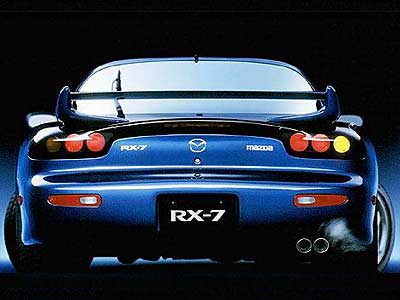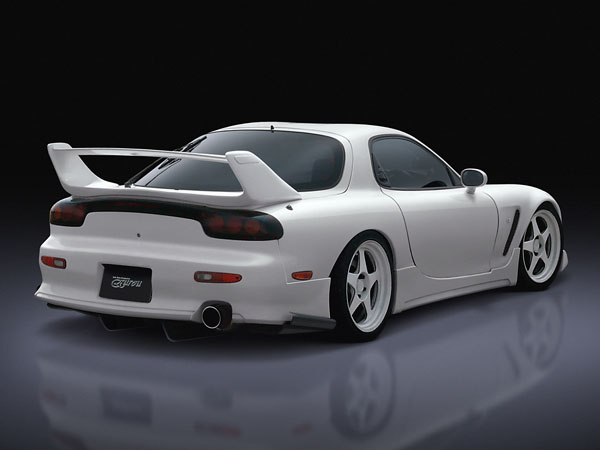Nothing quite as sentimental going on, but an article i read on Autospeed made me fall in love with the RX-7 all over again.
The car's aerodynamic properties are obvious just by glancing at it, but the numbers are still impressive. A wingless Cd of just 0.29 makes it cut through the air like the proverbial arrow shot by everyone's favorite blind flying baby. And even with the lip and spoiler, the Cd rises to 0.31, not too shabby for 90's sports car with factory aero mods! To add to the sweetness, the rear lift coefficient is practically negligible, 0.08. Despite the amazing attached flow on the rear end of the car. That would supposedly make any wing placed on the rear deck immensely efficient, right?
Admittedly, it is a small fly. Mazda's wind tunnel data, although unreferenced by Autospeed, shows that post stock R2 pack fitment, rear lift is completely unchanged. I.E. either Mazda is messing with the figures (likely) or the stock rear wing/spoiler design is naff and only cosmetic (just as likely), while the front lip is actually doing a good job of reducing lift, slashing it by a good 30%. Autospeed attributes the low rear lift figure to good use of underbody flows, and I tend to agree with them.
This (brief) clip of data helps explain a lot of trends in the Rx-7 aero upgrade market. Certainly, the company that makes most use of underbody flow is Scoot, for their wide bodied 4 rotor. By keeping the roof section and front nose pitch unchanged, Scoot are able to keep the excellent roof flow, while a huge rear diffuser and a subtle rear spoiler do the downforce dirty work. While this is technically very commendable, Its pretty obvious this kind of bodywork setup won't work for the street, or daily grind. The rear diffuser works well thanks to the lengthened tail section, and sticking it on by itself on the standard car won't do much good. By contrast, a setup like FEED's using a smaller diffuser and a GT wing can also cause problems, if not by having to depend solely on a huge aero add-on to keep the car stuck to the ground, it is also, in my opinion, ugly and it attracts too much attention for a component that is basically illegal here in Italy. On top of that, the wing area of the car isn't the only part of the car that could be improved.
So, if you want to go fast and not die young, what should one do? Well thankfully there are a lot of options for the inventive.
Since I've started talking about rear wings, I'll begin by closing that issue. There are lot of options out there on the market, but the only two worth considering that check all the boxes for aesthetics and functionality are:
The Mazdaspeed Type II rear wing:
Which some of you will recognise from Initial D
and (wait for it...)
The 99 Spec rear wing
yes, the stock one.
Both of these designs have a lot of appeal. They have adjustable pitch angles, so one can have it flat to decrease drag and ultimately save the planet, or heavily inclined and save yourself.
I prefer the Mazdaspeed wing for its slightly larger size and height. Also, I can't see any stops on the Mazdaspeed wing, presumably meaning it can be rotated indefinitely. If that's the case it could make an interesting side project for a motorized adjustable wing-cum-air-brake. But I'd need more info before I decide to take that path.
Thinking that these padawan wings don't have enough force to keep you down? well, theres an easy, inexpensive, incredibly effective solution to add bucketloads of push with little added drag. Add a flap. More specifically, a Gurney flap.
Dan Gurney invented the flap back in the 70's, with the concept in mind of adding a "spoiler" to a wing to help his struggling driver Bobby Unser regain confidence with his insufficiently rear loaded Indy car. The device was made and fitted in under an hour, but the times posted by Unser were still bad. Only this time, Unser was complaining that his car had so much downforce it was understeering. On top of that, the car was also posting higher top speed numbers. Interested? More information on Wikipedia. Has this been done on a 7 before? Indeed so! SAB Kobe / Sunshine Wharf / Woow City / Nagoya Bay etc. has a Gurney flap fitted to the stock wing on their Direzza Cup Time Attack car. I salute and thank RE Extreme for the pic, more pics and an article on the car here
With that, I would consider the rear wing chapter temporarily frozen. But there is still more room for improvement. I will enlist Autospeed's help yet again buy quoting this diagram:
If anything, this illustrates the magic worked by Mazda engineers in achieving smooth airflow anywhere possible. However, the choices made for the stock car don't necessarely apply for a tuned car.
In particular, everyone knows the biggest problem with Rotary engines is heat. This problem is exacerbated exponentially with increased power. the Pre 99 bumper just doesn't cut the mustard when it comes to supplying enough air to the radiator, FMIC (if applicable) and the twin oil coolers. Going all Fast and Furious with the front bumper won't make the car cut through the air any easier either, and ruining the looks of the 7 just isnt my thing. Solution is using the stock 99 spec front bumper to add the benefits of better cooling passages and a prettier face. It also has a negligible effect on the total frontal area and maintains an overall similar shape to the previous bumper, which is good enough for airflow as it is.
The other problem is the turbulence caused by the vent behind the front wheels. And no, it isnt there for engine bay cooling, Shame on you. It's real function is to release the pressure trapped within the front wheel arch. This turbulence is made worse by using aftermarket bigger wheels and wide tires, but as that is a handling prerequisite, it can't be touched. The only solution is to find a wider wheel arch (but not too wide) with a bigger vent to diffuse more air in a uniform way, and thus far the only arch I've found that seems to be suitable for that purpose is Aero Eurou's (their site is fantastic).
The other advantage is its low cost, though I'm not sure the rest of the kit is for me. The fender allows equal size wheels and tires which is ideal for 7's. Most people would prefer an RE style or FEED style fender with an open design vent. While this is surely more effective at releasing pressure, I'm worried about where the evacuated air is directed. If the angle of the evacuated air is too steep, i.e. it shoots air away from the car, it could cause all sorts of turbulent effects on the doors, thus solving a problem and causing another one. Also, an open lower section kind of defeats the point of a wheel arch, which is that of stopping debris from the tire from flying around.






